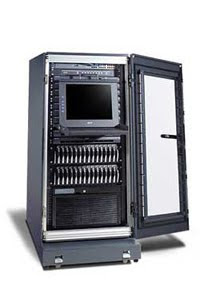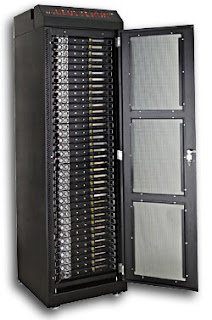
When it's time to choose a rack, there's a number of things to consider.
First of all, think about the usage of the rack. If you are going to have a frequent access to every sides of the equipment, then having an open rack will be more convenient than the use of cabinet. A rack pose offers open space for ventilation without limit. Also, make sure to do cable management for neat look.
Remember that racks are open. It's better to secure your equipment from nosey hands.
Next, it is recommended to have some knowledge about rack measurements since racks come in a variety of sizes and installation styles. The main part of a rack is a set of vertical rails with mounting holes to be attached with your rack shelves or equipment. There is usually an inch wide between the two rails to corresponded the hole on the opposing rail. Many of the rackmount equipment is built to fit 19" rail, but it can be adjusted for larger racks.
Rack unit, also known in abbreviation as "U," is another important specification. Rack unit measures vertical space available on rails, cabinets, racks and rackmount equipment. One rack unit (1U) is equal to 1.75" of valid vertical space.
Due to the standard of the width, vertical space is used to determine the amount of equipment you are able to install.
 Then, it's time to find power for your equipment. Consider what kind of power strip suits your installation the best. Some may come with outlets, and some might be made to use vertically or horizontally. Also, make sure if the power strips have built-in surge protection. If not, it is good to have UPS to prevent your equipment from crashing especially when there's an outage or electrical failure, so you can have some time to shut down things properly.
Then, it's time to find power for your equipment. Consider what kind of power strip suits your installation the best. Some may come with outlets, and some might be made to use vertically or horizontally. Also, make sure if the power strips have built-in surge protection. If not, it is good to have UPS to prevent your equipment from crashing especially when there's an outage or electrical failure, so you can have some time to shut down things properly.After having all your equipment mounted tidily, cable cords are what need to work on. It's wise to have your cables managed, so you will never have to end up with a restless day trying to unravel the messy cords. To do so, plan the most practical way to organize your cables by knowing your connections. Cabling is one of the most found problems in the network. Thus, it is advised to get rid of the problem earlier, so that you won't have to worry about it in the future.
Other resources: Rack Shelf
No comments:
Post a Comment
Note: Only a member of this blog may post a comment.